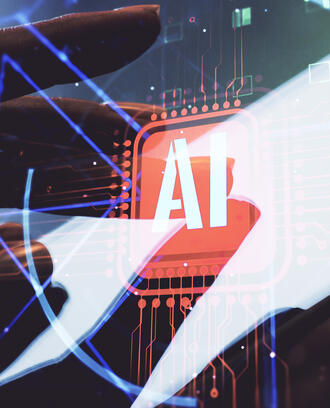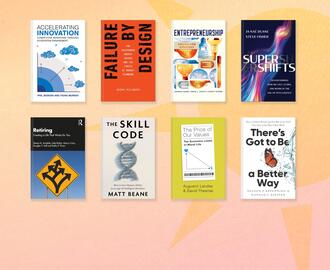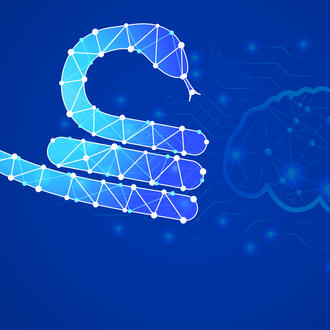Credit: Jennifer Tapias Derch
MIT Sloan research on artificial intelligence and machine learning
There’s little question artificial intelligence and machine learning are playing an increased role in making business decisions. A 2022 survey of senior data and technology executives by NewVantage Partners found that 92% of large companies reported achieving returns on their data and AI investments — an increase from 48% in 2017.
But as these technologies enter the mainstream, new issues arise: How will they change the nature of workflow and workplace connection? Will they be ethically harnessed? Will they replace humans?
Here’s what to consider as AI and machine learning become omnipresent, according to MIT Sloan researchers, visiting scholars, and industry experts.
Artificial intelligence is changing most occupations, but it is far from replacing humans, according to a book examining the findings of the MIT Task Force on the Work of the Future.
Some 92% of large companies report that they are achieving returns on their investments in data and artificial intelligence.
MIT researchers David Autor, David Mindell, and Elisabeth B. Reynolds argue it is essential to understand the capabilities and limitations of artificial intelligence as we think about how it will impact jobs.
Today’s AI challenges center around physical dexterity, social interaction, and judgment. Consider a home health aide, whose responsibilities include providing physical assistance to a fragile human, observing their behavior, and communicating with family and doctors. Not until automation reaches that level can it truly be considered what scholars call “artificial general intelligence."
It’s possible to harness AI to create a more equitable future. Across industries, workers are worried that automation and artificial intelligence will steal their jobs. MIT Sloan professor of managementshares those concerns, but also sees “tremendous” innovative potential in new technologies to create “a productive and more equitable future.”
In his online executive education course, “Leading the Future of Work,” Kochan lays out a four-pronged roadmap for work of the future:
- Strive to become a “high road” company that creates value for all stakeholders, including their employees.
- Use advanced technology to drive innovation and augment work.
- Train and upskill the workforce to work alongside new technologies.
- Rebuild a dialogue with labor leaders for a mutually beneficial future.
An AI-fueled productivity boom is on the way. Consider the internet: Its fundamental technologies took root in the 1960s and 1970s but didn’t become commercialized until the mid-1990s. Stanford University’s Erik Brynjolfsson, part of the MIT Task Force on the Work of the Future, calls this phenomenon a “J-curve,” when technological acceptance is “slow and incremental at first, then accelerates to break through into broad acceptance.”
Now, businesses should prepare for an AI-fueled J-curve as the technology takes off. Companies should focus on incorporating artificial intelligence and machine learning into work processes and preparing employees, Brynjolfsson said at an EmTech Next conference, while policymakers should move to ensure its adoption doesn’t contribute to inequality.
Related Articles
AI requires stakeholder buy-in. Machine learning tools are used in a variety of fields. But getting tech into the workplace is just one step — these tools are only successful if they’re integrated into workflows and if people trust them enough to depend on them.
A key to successful adoption is an ongoing dialogue between technology developers and end users, according to research from MIT Sloan professorand co-authors.
“Managers and developers need to engage in a back-and-forth process to build, evaluate, and refine the tools in order for them to be useful in practice,” Kellogg said.
Moreover, stakeholders need to believe that AI programs are accurate and trustworthy. Artificial intelligence explainability can help. Researchers from the MIT Center for Information Systems Research define AI explainability as “the ability to manage AI initiatives in ways that ensure models are value-generating, compliant, representative, and reliable.”
Artificial intelligence explainability is an emerging field, the researchers admit. They recommend that companies start by identifying units and organizations that are already creating effective AI explanations, and identifying practices that the organization’s own AI project teams have already adopted.
AI and machine learning are transforming digital marketing. Most marketers are concerned about retention and revenue, but without good forecasts, decisions about effective marketing interventions can be arbitrary, saidsocial and digital experimentation research group lead at the MIT Initiative on the Digital Economy.
Machine learning will change that, helping to predict customer behavior and intuit customer needs.
“There’s a lot of value to applying statistical machine learning to predict long-term and hard-to-measure outcomes,” Eckles said.
Companies such as Wayfair and Spotify leverage machine learning for bespoke customer experiences, from highly tailored furniture search results to personalized suggested playlists. And, when COVID-19 spread, Moderna used its long-held automated processes and AI algorithms to increase the number of small-scale messenger RNA (mRNA) needed to run clinical experiments. This groundwork contributed to Moderna releasing one of the first COVID-19 vaccines (using mRNA) in the pandemic’s early days.
Good data makes for good AI. Having five essential data capabilities, such as data scientists and a data platform, helps companies build successful artificial intelligence programs.
The key is to take an enterprise — rather than local — perspective as AI project teams learn and mature, according to researchers from MIT CISR. When companies identify and accumulate expertise and practices from their AI teams, they can create reusable and refinable practices and build capability. This accelerates new AI projects and sets up those future teams for success.
Embracing data-centric AI is also important. This is “the discipline of systematically engineering the data needed to build a successful AI system,” according to Andrew Ng, SM ’98, founder of the Google Brain research lab and former chief scientist at Baidu.
Focusing on high-quality data that's consistently labeled could unlock the value of AI for sectors such as health care, government technology, and manufacturing, Ng said at a EmTech Digital conference.
And even if AI can’t solve all of the world’s problems — and might even cause some new ones along the way — it can at least make Wordle a little bit easier to solve.
Read next: SEC’s Gary Gensler on how AI is changing finance



